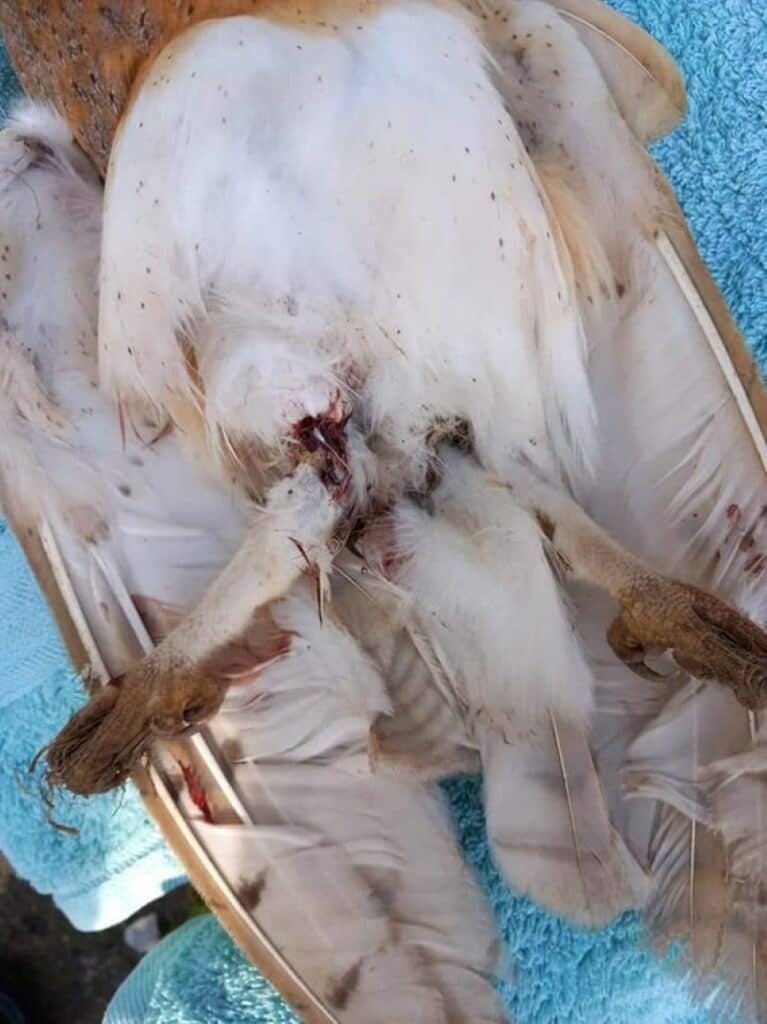Illegally set spring trap causes death of Barn Owl
North Yorkshire Police have reported on the sentencing of a man after the death of a Barn Owl trapped illegally on an allotment plot in Hunmanby, near Scarborough.
On 8 April 2023, a dog walker discovered a badly-injured adult Barn Owl caught in a spring-operated trap in the allotments at Sands Lane, Hunmanby. Despite the bird being rescued and taken to a vet, the injuries to its legs were so severe that it had to be euthanized.
When spoken to by police, the tenant of the plot, Leslie Shooter, 57, stated that he had set a number of traps to control rats. However, he had not covered the traps as required by law, resulting in the trapping of the bird.
Following an investigation by North Yorkshire Police, Shooter was charged with using an animal trap in circumstances for which it is not approved, causing a trap to be set to cause injury to a wild bird and causing unnecessary suffering to a protected animal.
After pleading guilty at Scarborough Magistrates Court on 29 June 2023, Shooter was sentenced to a community order with 100 hours' unpaid work requirement, as well as £199 of costs and surcharges.

Spring Traps and the Law
We have covered the use of spring traps in our Protectors of the Wild page > Spring Traps and the Law.
Widely used on shooting estates to kill small mammals, these horrendous traps are still legal but subject to legislation. In England and Wales under the Pest Act 1954, section 8, in Scotland under the Agriculture (Scotland) Act 1948, section 50, and in Northern Ireland under the Wildlife and Natural Environment Act (Northern Ireland) 2011, section 11, it is an offence, in respect of any animal to use or permit the use of a spring trap not approved by the government agencies under Spring Trap Approval Orders (STAOs).
These Orders lay out which trap can be used to catch specific species - clearly they do not list Barn Owls, which are listed in Schedule 1 of the Wildlife & Countryside Act 1981 and (like all birds of prey) are fully protected by law (see our Protectors page > Birds of Prey and the Law).
Additionally, the way spring traps should be used is legislated:
Spring traps should be set in an artificial or natural tunnel to prevent the access of non-target species (it is illegal to lay them in the open) and the entrance of trap tunnels should be restricted or narrowed to prevent the entry of non-target species.
In Scotland, the trap ‘must be set in a natural or artificial tunnel which is suitable for minimising the chances of capturing, killing or injuring non–target species whilst not compromising the killing or taking of target species’.
Spring traps should be set as ‘to prevent an unlawful catch of the target species’ ie not set with a risk of the animal being caught by the leg or tail.
Spring traps should be firmly anchored.
Spring traps should be checked at regular intervals based on legislative requirements.
Spring traps must not be set in open or accessible areas where members of the public, animals and pets can gain access to them.
The injuries caused to this Barn Owl are sadly reminiscent of the catastrophic damage caused to Rannoch, a young Hen Harrier found dead in a spring trap on a grouse moor in Perthshire a few years ago, and by 'pole traps', spring traps with toothed jaws set out on poles that birds of prey use to monitor their territory or look for prey. Pole traps have been banned in England and Wales since 1958 and fully banned in Scotland since 1973, but are still sometimes found on shooting estates.
Barn Owls
Dominated by shooting estates, North Yorkshire is renowned as one of the worst regions in the UK for raptor persecution.
While there is no suggestion that Shooter is connected with gamekeeping or estates, it does seem odd that his first thought to 'control rats' as he claimed was to turn to powerful spring traps which barely anyone outside gamekeeping knows about. Besides which, rats are highly intelligent animals, and won't just walk into traps lying about in the open. That he combined his lack of knowledge of wild animal behaviour with having no idea how to use the trap legally is sadly typical (unless he knew damn well but couldn't care less anyway).
Frustratingly, as well as being beautiful and emblematic of open countryside, Barn Owls are of course highly efficient predators. Their main prey is rodents. Struggling due to lack of prey because of intensive farming and secondary poisoning from second-generation rat poisons, this would have been a perfect opportunity for an allotment owner to support a family of Barn Owls by doing absolutely nothing more than letting them be.
Instead, ignorance and short-termism has done the exact opposite.



